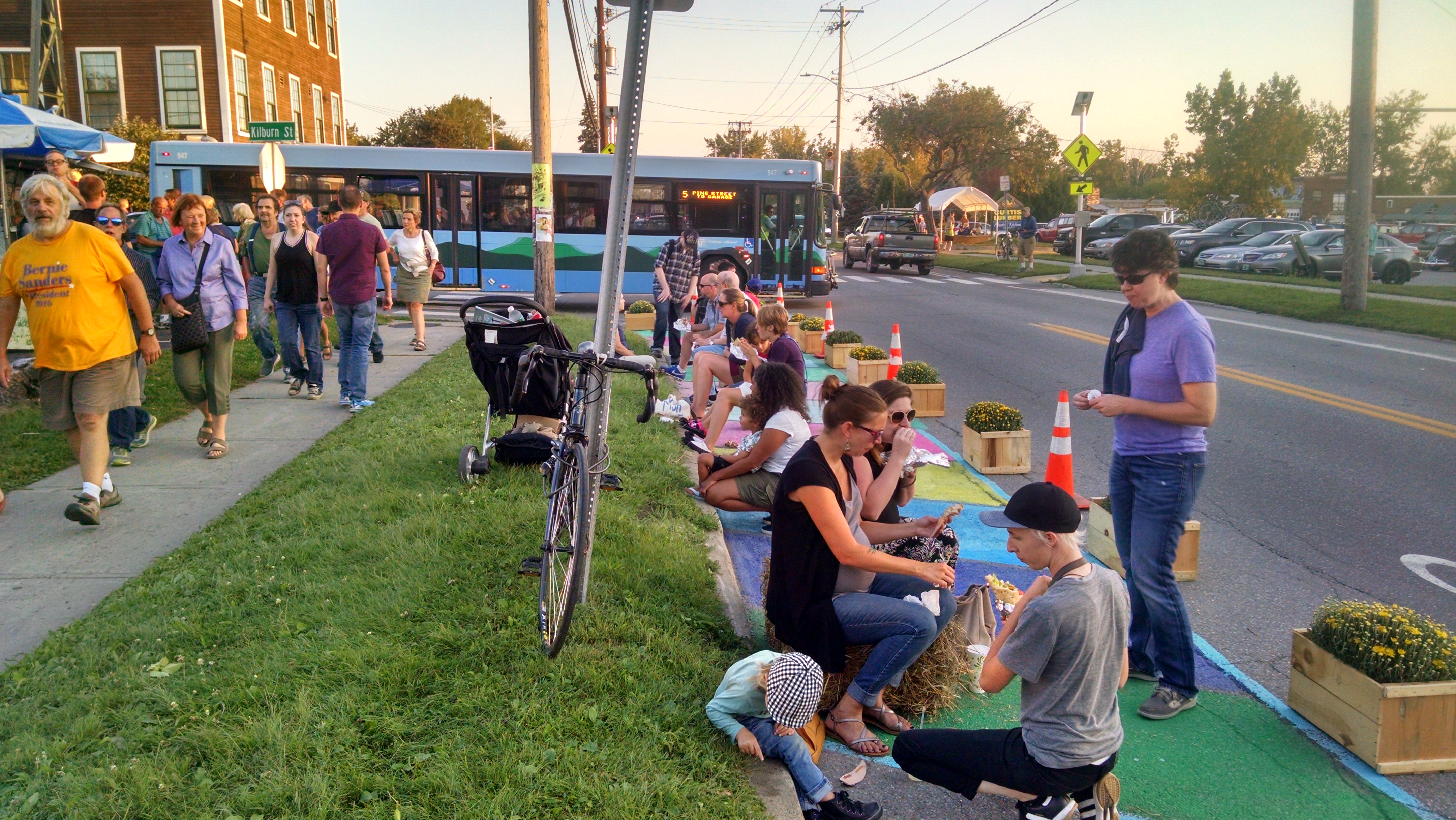
The raffish, worldwide movement known as tactical urbanism appears poised to take on a meatier role in improving transit in bus corridors. By providing low cost, agile alternatives to lengthy street improvement processes, “tactical transit” has the ability to jump start virtuous cycles of increasing bus ridership by speeding up travel times, improving passenger experience and enhancing overall perceptions of riding the bus.
Tactical urbanism has proven itself particularly adroit in demonstrating the efficacy and public support for protected bike lanes and plazas – the pedestrianization of Times Square of course the most visible, pioneering example. It now presents enormous potential to begin transforming the way that transportation agencies implement bus-related projects. Instead of undergoing lengthy procurement processes or depleting financial or political resources, transit agencies can begin improving the physical environment in which buses operate with the tools that can deliver in the near-term. Indeed, some cities are already leading the way.
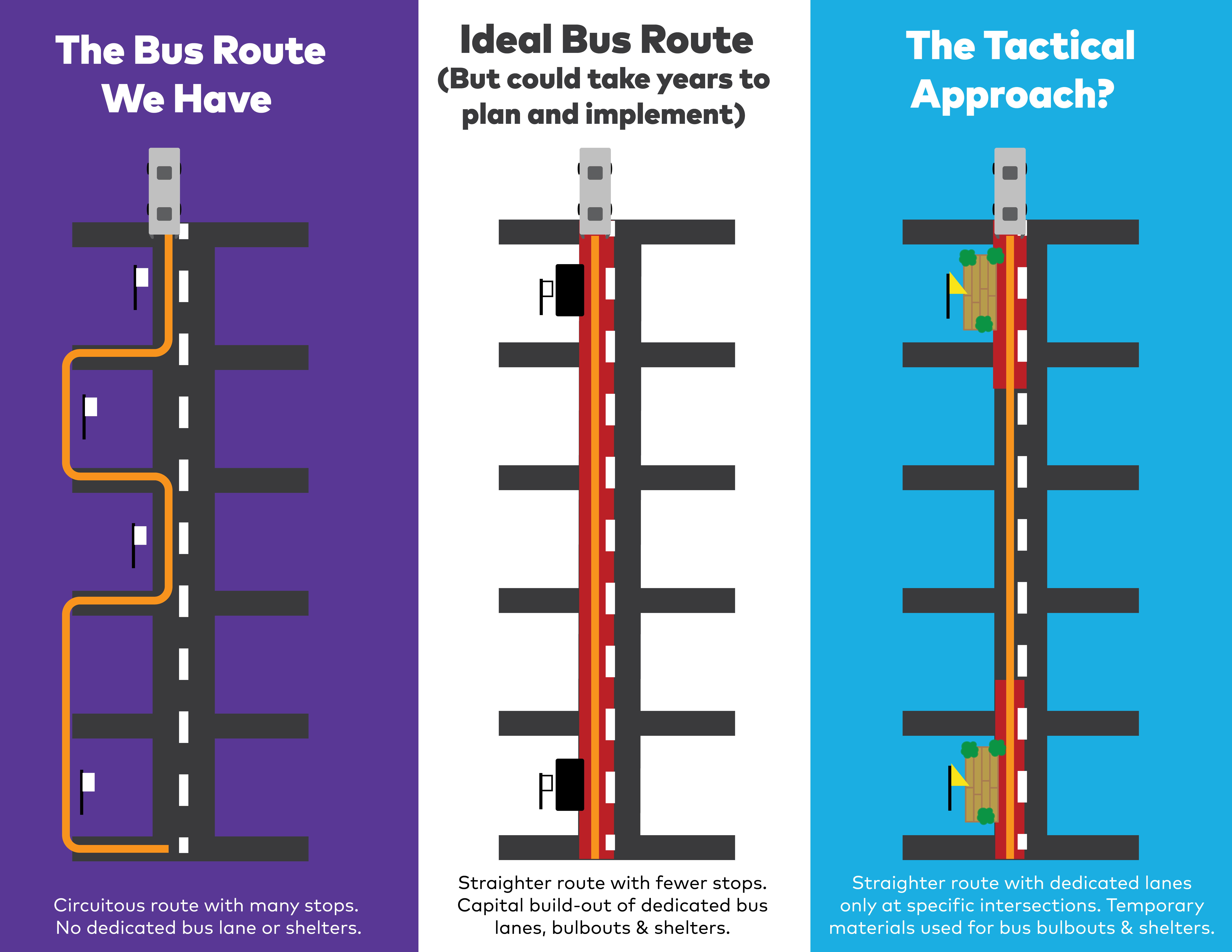
How tactical transit could shift transportation planning
In Everett, Massachusetts, a pilot project recently transformed a parking lane in a heavily congested portion of Broadway/Route 99 into bus-only lane during rush hour. Requiring no engineering investment, the project merely relies on orange safety cones and temporary signage to demarcate the lane. Initial data indicates that commute times have been reduced anywhere from 4-8 minutes, and both bus riders and car commuters have embraced the project because it has improved traffic flow overall. According to City transportation planner Jay Monty, Everett has decided to extend the pilot indefinitely and is exploring ways to expand the route.
The New York City Department of Transportation has been using what could be considered tactical techniques since 2008, when it debuted the Select Bus Service program in partnership with the MTA. The first effort on the Bronx’ Fordham Road was rapidly implemented with painted bus lanes and repurposed parking meters (for curbside fare collection). Recently, the city expanded its “quick delivery” repertoire for bus corridors with a rubber bus bulbout along the Utica Avenue corridor rather than traditional cement. The agency is waiting to see how the hardware survives the winter before expanding their use.
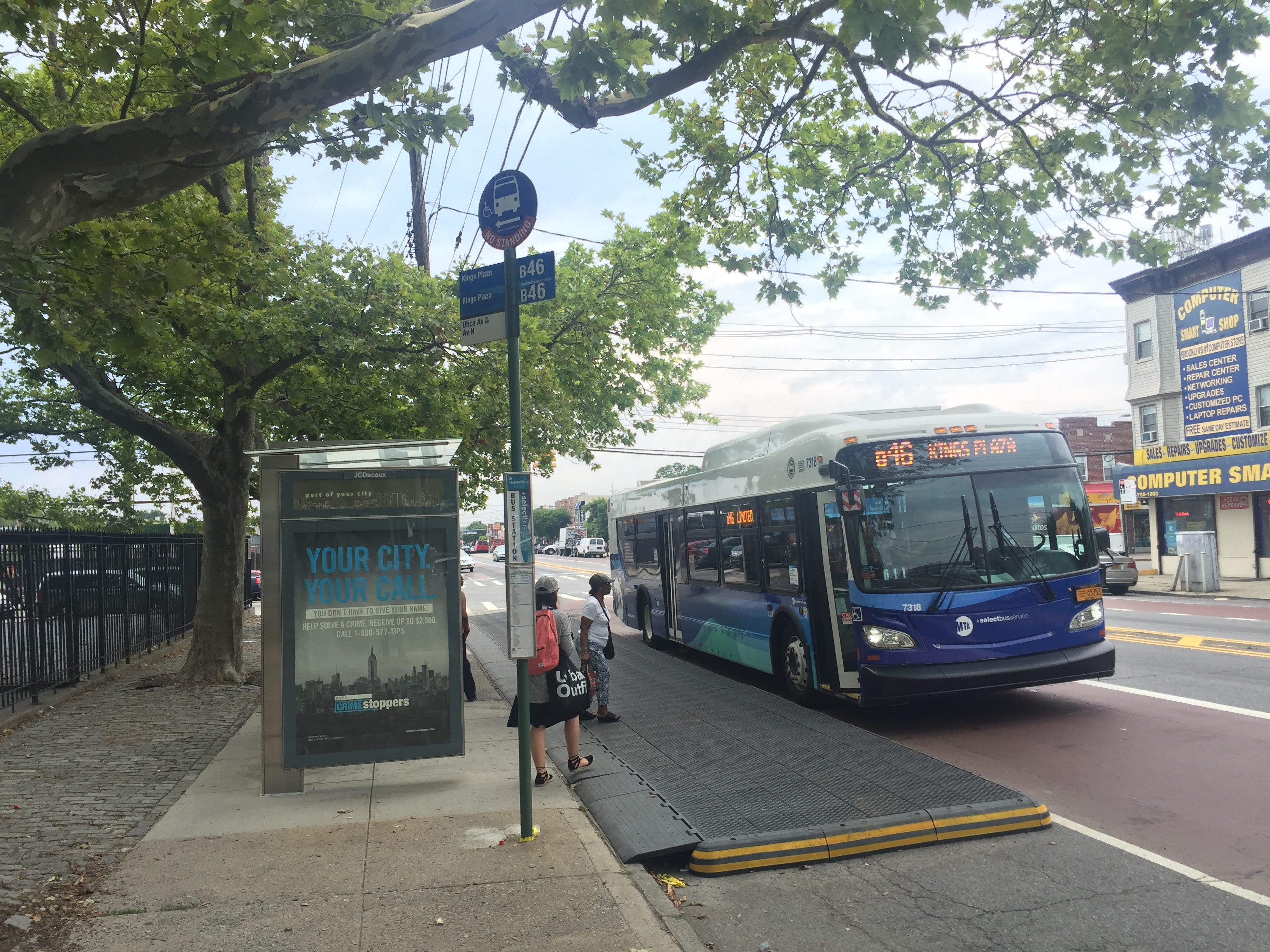
Testing out a temporary bulbout along Utica Avenue in Brooklyn
Another agency exploring tactical bulbouts is AC Transit in Albany, CA, a city north of Oakland. The agency plans to debut a “stoplet” in March of 2017, which is part bus bulbout, part parklet. According to project manager Stephen Newhouse, “the relatively low cost and quick delivery timeline of the stoplet helps the agency establish credibility with the public. It allows us to demonstrate that we are frugal, action-oriented, and adaptable.” Additionally the agency hopes that this marriage of parklets and bus stops will improve overall operations in a dense commercial corridor with many competing interests for right-of-way. By creating something that both passengers and adjacent businesses will see as an amenity, “the stoplet model could turn what is traditionally thought of as a zero-sum game into a win-win for transit agencies, communities, and our customers,” says Newhouse.
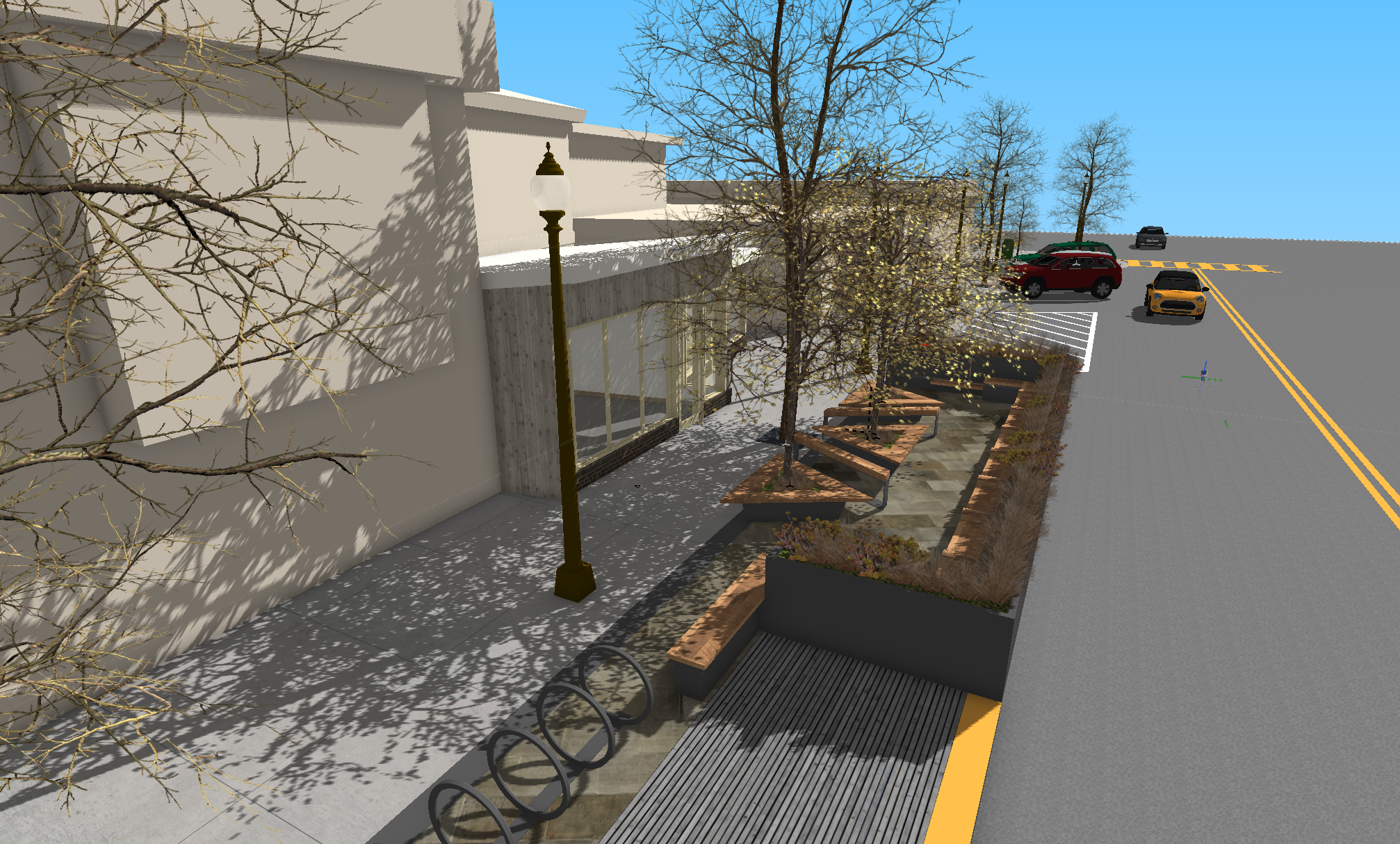
Architectural Rendering of AC Transit’s Stoplet
An agency that used the stoplet or modular bulb-out at bus stops in combination with proven safety and walkability enhancements such as sidewalk extensions or intersection simplification could forge great transit corridors from unwelcoming, car-oriented arterials within a year’s time. This kind of combined deployment would be particularly well-suited to cities with transit aspirations such as Nashville or Charlotte, but has clear application throughout the United States.

“Tactical” sidewalk extensions in Brooklyn
Temporary materials can also provide an alternative to glacial-paced placement when it comes to bus shelters. In Louisville, Ioby’s Trick Out My Trip initiative recently allowed a coalition of community members to quickly construct two bus stops that are both aesthetically pleasing and designed with a passenger’s comfort in mind. According to project organizer Julienne Chen, “we wanted to make a visible statement about the role that buses have to play in our community and that they are also valued modes of transport. We hope that the project shows that there are small, tangible improvements that can be made to start shifting the conversation about how people think about taking buses – and what their experience is once they decide to take a bus.”
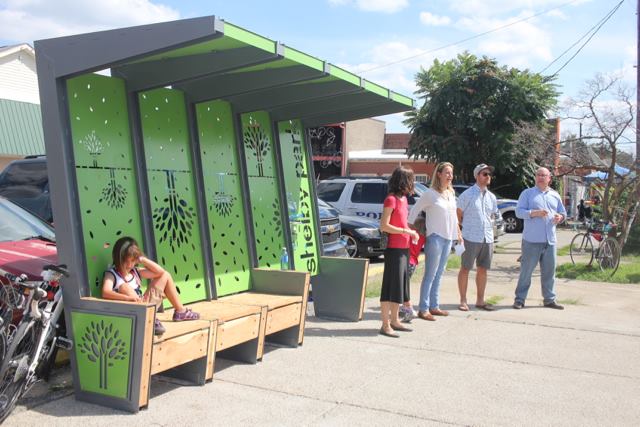
Louisville “TransporStation” Project
What might ensure the scalability and ultimate success of these types of initiatives? Chen highlighted the importance of engaging early on with stakeholders and building ownership. She says it’s also critical to quickly address the “unsexy” things like maintenance, liability, engineering and design standards, right of way requirements and installation – things that tend to get lost amidst the excitement of a novel project. Regrettably, in Louisville additional bus stops will have to be citizen rather than agency-led, as the local transit authority TARC already has an existing contract for bus shelters. However, while perhaps not yet a policy adoption, Chen says that the project has ignited dialogue between the public and government agencies about how to best put the users at the center of bus stop design.
Over at AC Transit, however, Newhouse is optimistic about the scaling prospects for his stoplet and expects that the completion of the first one will pave the way for agency-wide adoption of this method. “I think the greatest challenge to adopting tactical urbanism is internal,” says Newhouse. “Overcoming fear of failure and restrictive procurement processes is key. The best thing transit agencies and governing bodies can do to capitalize on tactical urbanism is create a safe space for innovation from within.”

Streets getting tactical in Burlington, Vermont
 On the Brink: Will WMATA’s Progress Be Erased by 2024?
On the Brink: Will WMATA’s Progress Be Erased by 2024?
The experience of being a WMATA rider has substantially improved over the last 18 months, thanks to changes the agency has made like adding off-peak service and simplifying fares. Things are about to get even better with the launch of all-door boarding later this fall, overnight bus service on some lines starting in December, and an ambitious plan to redesign the Metrobus network. But all of this could go away by July 1, 2024.
Read More A Bus Agenda for New York City Mayor Eric Adams
A Bus Agenda for New York City Mayor Eric Adams
To create the “state-of-the-art bus transit system” of his campaign platform, Mayor Adams will have to both expand the quantity and improve the quality of bus lanes. We recommend these strategies to get it done.
Read More